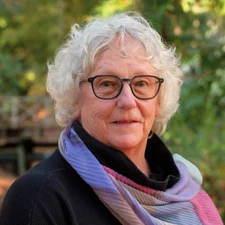Mary K. Firestone

The 2022 Philippe Duchaufour Medal is awarded to Mary K. Firestone for outstanding research exploring the interactions between soil physicochemical conditions, soil microbial activity, plants and nutrient cycling processes.
Mary Firestone has led pioneering work throughout her career, following challenging research questions without stopping at disciplinary boundaries.
Firestone intensively explored the interactions between soil physicochemical conditions, soil microbial activity, plants and nutrient cycling processes. She has followed this quest, driven by questions and hypotheses rather than by technological progress, all the while developing and using new technology (namely omics approaches) to help push her understanding forward. As a result, Firestone was able to access a holistic vision of the soil as a true system, which resulted in major advances that gave a new shape to the research field, as listed below.
The Nature of Nitrogen (N) Cycling in Soils: Firestone articulated a highly influential conceptual model of the factors that influence rates of denitrification and its partitioning into nitric oxide, nitrous oxide, and dinitrogen emissions. Her “hole-in-the-pipe” model is regularly used to frame current research on denitrification. Firestone also pioneered the use of stable isotopes as tools to characterize and quantify aspects of the soil N cycle that previously were poorly understood, including pool-dilution techniques to measure gross rates of N transformations and tracers to follow the fate of N through ecosystems. Work from and inspired by Firestone’s lab led to several novel insights, including that there is little correspondence between the pool sizes of inorganic N, net rates of N transformations, and gross N fluxes in N. Her research showed that even where N pools are small and net N transformation rates are slow, turnover of N can be rapid, revealing a N cycle that is considerably more dynamic than previously appreciated.
Microbial Communities and Ecosystem Processes: The advent of ever more sophisticated techniques to characterize the composition and diversity of microbial communities begs the question: does variation in microbial community composition ever matter to ecosystem functioning? Firestone was one of the first to question the old adage “everything is everywhere, but the environment selects”, by taking advantage of technological advances for characterizing microbial communities to probe this assumption in the context of N cycling and soil organic matter dynamics in ecosystems from tropical forests to Mediterranean grasslands.
Soil Water and Microbial Activity: Firestone’s research has explored the physiological responses of soil microbes to desiccation stress, particularly how soil water influences diffusion of extracellular enzymes and substrates, and how microbes lower their own osmotic potential to avoid drying out as soils dry. Firestone’s research has demonstrated ecosystem-level consequences of microbial osmotic regulation and of diffusion limitation of microbially mediated processes.
It is impressive to see that her thirst for better understanding of soil functioning still runs high: in the last years she has included new biological players in the picture, namely viruses. Her induction at the USA National Academy of Sciences is a clear recognition of her outstanding scientific achievements.
Mary Firestone’s voice is highly respected in soil system sciences, because it carries creativity, curiosity and enthusiasm. Awarding her the Philippe Duchaufour Medal is an inspiration to the next generations of researchers.
